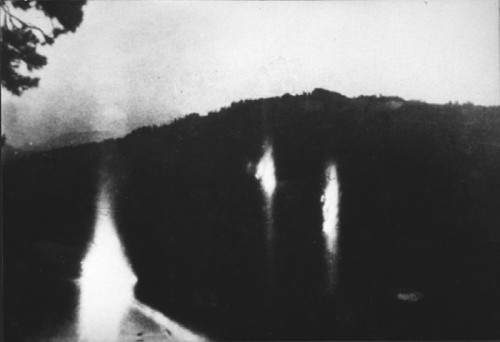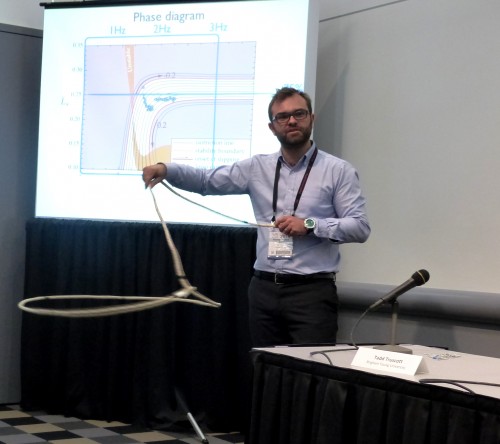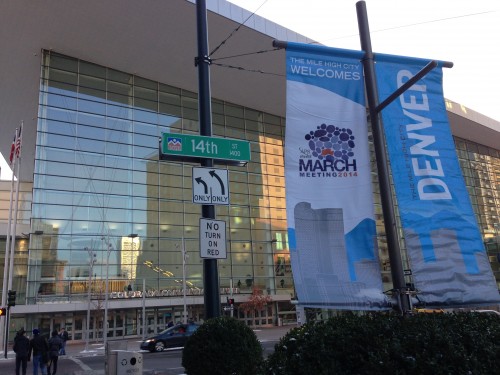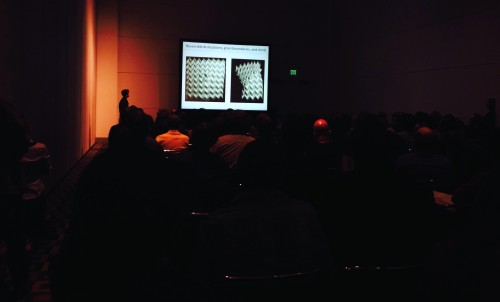Category Archives: APS March Meeting 2014
Cracking the earthquake lights mystery and out-of-this-world technology

A photograph of streams of lights taken in 1977 near Brasov, Romania, about 100 km from the epicentre of a M 7.2 earthquake. (Courtesy: Seismological Society of America)
By Tushna Commissariat
In case you missed it, I was at the APS March meeting in Denver, Colorado last week and I was blogging about a whole host of interesting talks and sessions that I attended. Although I am back in Bristol now, there were one or two other talks that I thought covered some very interesting physics, so here’s a catch-up.
Slip slidin’ away
Seasoned physicsworld.com readers will remember that earlier this year, we featured a rather intriguing story on the phenomenon of earthquake lights – the mysterious and unpredictable glowing lights that seem to appear before some earthquakes. First documented in the 1600s and seen as recently as the Fukushima earthquake of 2011, the “unidentified glowing objects” add to the long list of possible earthquake precursors, and so are of interest. The study that we wrote about in January looked at 65 well-documented events of such lights and concluded that they may occur thanks to a particular type of geological fault – a subvertical fault – causing the earthquake.
Robotic cowboys and clams, the SQUID at 50 and more

Pierre-Thomas Brun shows off his lassoing skills.
By Tushna Commissariat at the APS March Meeting in Denver
It has been another exceedingly busy day the APS March Meeting – there were sessions on the SQUID’s many applications, robotic clams, global health physics and the spread of epidemics, and even some toys based on physics principles. Here’s another quick round-up of the fascinating talks.
On SQUID row
It’s the 50th birthday of the superconducting quantum interference device or SQUID – a very sensitive magnetometer that accurately measures extremely subtle magnetic fields – this year, and there were sessions this morning to discuss its impact to date as well as possible future applications. Kent Irwin from Stanford University discussed how superconducting photon detectors that are used in a host of astronomical and cosmological observations are being amplified using SQUIDs. Such SQUID-boosted sensors are being used to make more accurate measurements of the cosmic microwave background (CMB) – to look at its power as well as certain polarizations modes it exhibits. As certain experiments look for signs of gravitational waves in in the CMB polarization, this could be particularly helpful.
View all posts by this author | View this author's profile
Partying bacterial biofilms throw out streamers
By Tushna Commissariat at the APS March Meeting in Denver
The word “streamers” doesn’t normally bring bacteria to mind, but it’s all the rage with biophysicists studying the mechanics of bacterial biofilms that grow where there is fluid flowing. A biofilm is any group of microorganisms where cells stick to each other on a surface – either a living or non-living surface will do. A rather simple example of this is the slimy film that develops over our teeth each night.
Biophysicist Knut Drescher from Princeton University gave a fascinating talk at the APS March Meeting on Monday about his research into why biofilms that grow specifically in the presence of a flowing fluid – such as in channels in soil, filtration systems, as well as medical devices such as stents or urinary catheters – are rapidly clogged, causing a variety of problems and infections. Biofilms in such a case form 3D thread-like “streamers” that are responsible for the rapid clogging. It was initially thought that these streamers formed along the walls of the original film and then expanded inwards, but Drescher and colleagues found that it was actually the other way around – the fishing-line-like streamers grew from the middle and rapidly extended outwards, clogging a channel within minutes.
View all posts by this author | View this author's profile
Magnetic supreme court judges, easier visa access, visualizing arXiv and more

From left to right, Lee talks about his supreme court model, as Alemi and Zeng listen in.
By Tushna Commissariat at the APS March Meeting in Denver
With the amazing variety of interesting talks at the APS meeting yesterday, I couldn’t possibly write up each and every one – I’d have to take today off, and there’s yet more physics to be learned today! In light of that, below is a short round-up of some of yesterday’s speakers and their work.
View all posts by this author | View this author's profile
‘Mile-high’ physics

By Tushna Commissariat at the APS March Meeting in Denver
The city of Denver, Colorado has been invaded…or so I am sure the locals will feel over the next few days, as more than 9000 physicists from all over the world have arrived to take part in the APS March Meeting. I have been here in the “Mile-high city” of Denver – so nicknamed thanks to its official elevation that is exactly one mile or 5280 feet above sea level – since Sunday morning, and physics is the talk of the town as everyone descends upon the Colorado Convention Center (pictured above).
As always, there is a wide variety of interesting talks, sessions and press conferences over the next few days and I would have to clone myself multiple times to get around to all of them. Talking about cloning, though – I have just been to my first session, where Stanford researcher Patrick Hayden was taking about quantum information and asking whether or not it could be cloned in space–time. I will be speaking with Hayden later in the day, so watch this space if you would like to know more.
